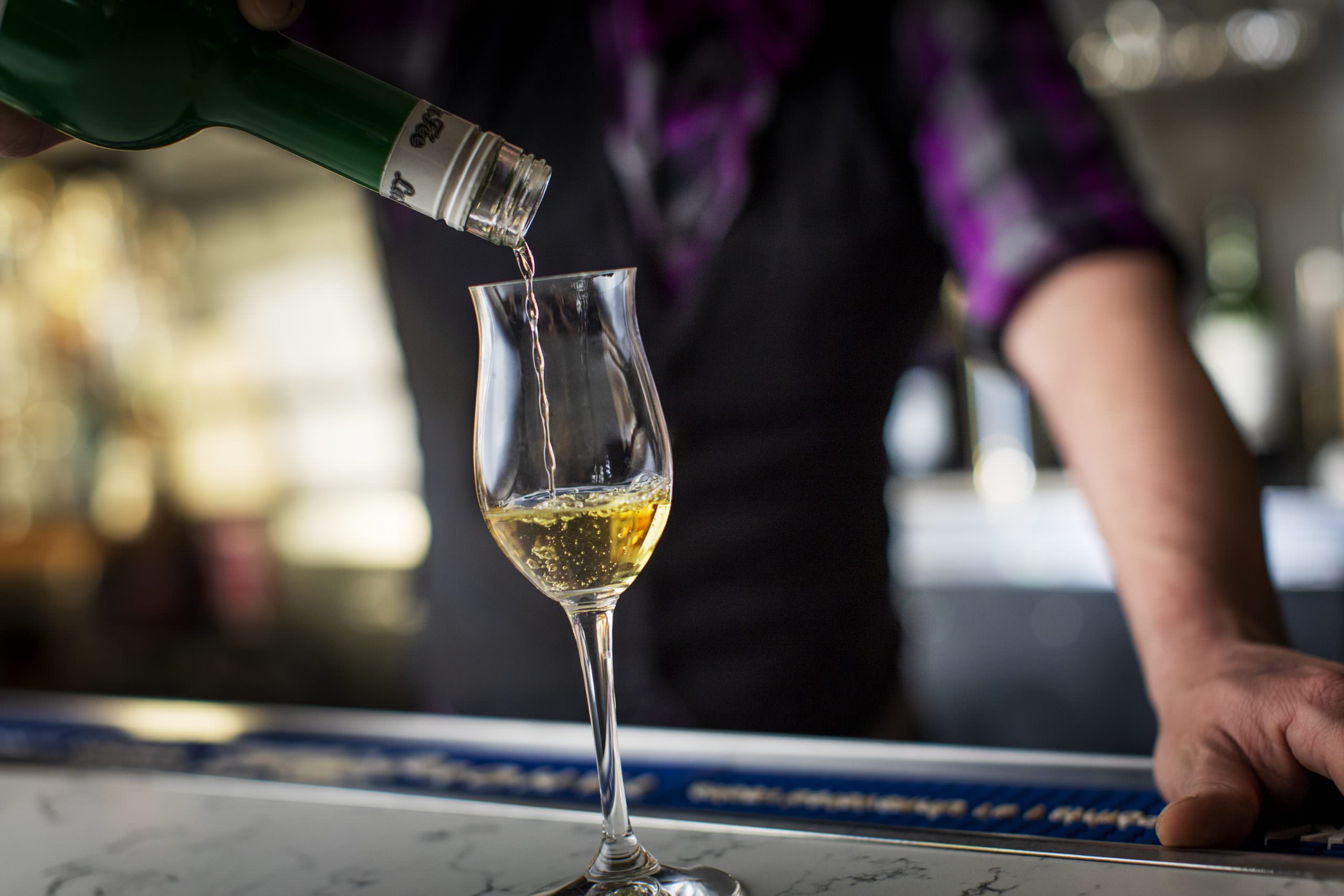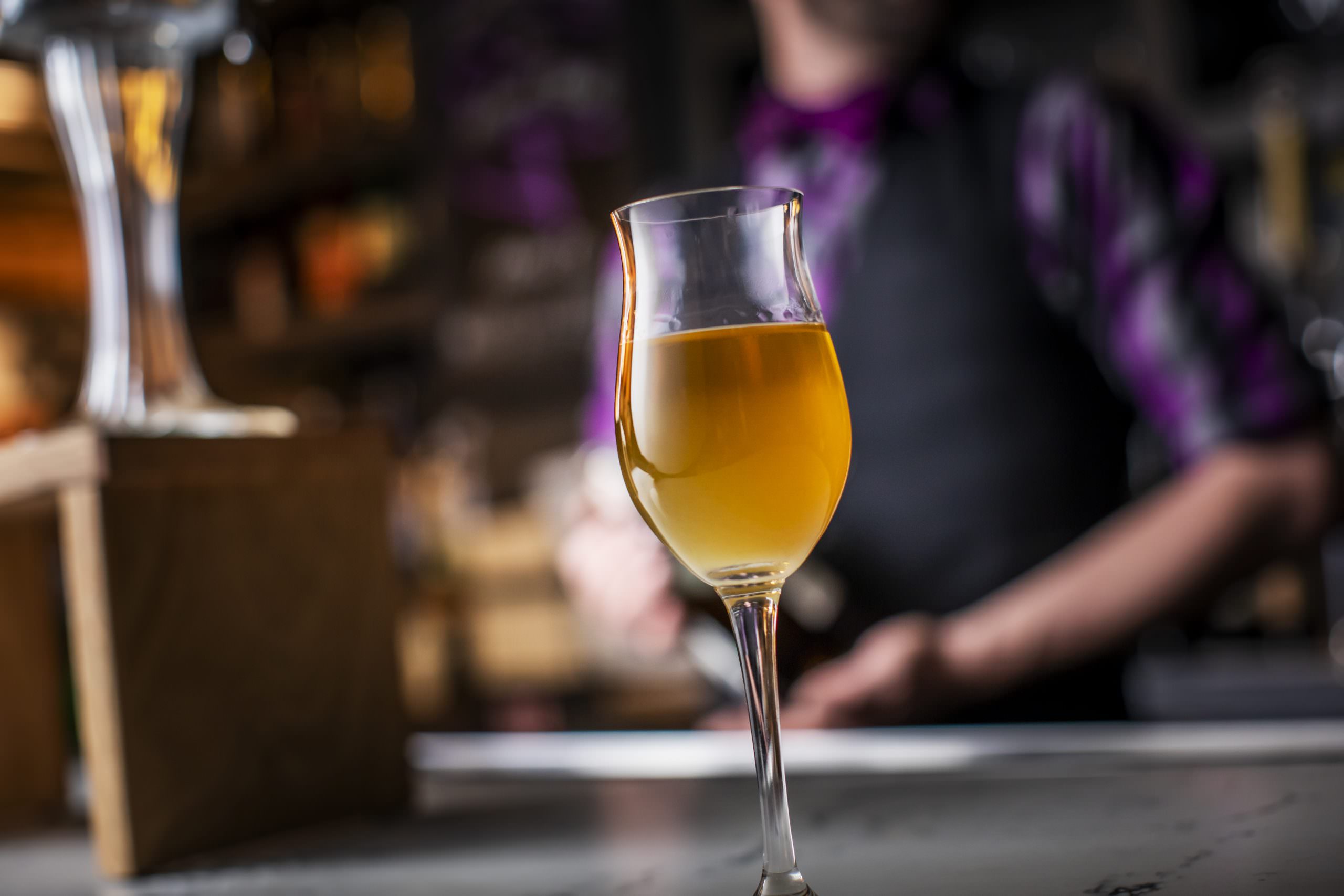Absinthe’s fascinating history and local resurgence.
A grinning, green-hued fairy emerges from the bottle upon opening, intent on intoxicating whoever released her from captivity. This is no magical genie from childhood fables. It’s an image from the long-ago lore of absinthe.
Legend has long surrounded this libation. Medicinal benefits of absinthe’s primary ingredient, Artemisia absinthium, known as wormwood, were first discovered in ancient Egypt and primarily used to treat pain and fever. Either Dr. Pierre Ordinaire or Madame Henriod — which of them truly was first is frequently debated — concocted a blend of wormwood and other botanicals, dubbed absinthe, in the late 18th century in Couvet, Switzerland. It was sold as a medicinal cough syrup and restorative tonic.
Many monikers were imparted upon this curiously colored spirit when its popularity skyrocketed in the 19th century. Notably creative minds and devout drinkers of absinthe dubbed it la fée verte, French for the green fairy. It also was deemed the green muse, as many renowned artists and authors such as Van Gogh, Picasso, Hemingway, and Toulouse-Lautrec credited absinthe for their inspiration.
Blame it on the booze

Burke performs the louche process with a glass of absinthe. He places a slotted absinthe spoon on the glass and sits a sugar cube on top. The glass is positioned under the fountain and ice water is slowly dripped over the sugar into the absinthe, which dilutes the drink and gives it a cloudy appearance
“After the first glass you see things as you wish they were. After the second, you see things as they are not. Finally, you see things as they really are, and that is the most horrible thing in the world.”
These were the words of Oscar Wilde to describe the effects of absinthe to his friend, Ada Leverson. Previously, an unsubstantiated rumor still shared today claims that ingesting excessive amounts of absinthe drove Van Gogh to cut off his own ear.
It was a beverage so beloved by Parisian bohemians during the Belle Époque of the late 19th and early 20th centuries that the green hour, or l’heure vert, was instituted daily at 5 p.m. Many period paintings featured subjects partaking in absinthe, others depicted its nickname-inspiring fairy, and books and poems were authored sharing its glories.
Eventually, stories of its purported mind-bending, hallucinatory effects spurred darker tales. As absinthe consumption proliferated across Europe, it left a wake of tragedies blamed on the booze, from the legendary painter’s alleged ear excision to a Swiss man murdering his entire family. Absinthe became villainized. Its ban began in many European countries in 1906, and in the U.S. in 1912, lasting about a century.
What a trip
Does absinthe have psychogenic effects?
Absinthe’s primary ingredients are fennel, anise, and wormwood, distilled with a neutral-base alcohol and often additional botanicals, such as peppermint, hyssop, and coriander.
Wormwood does, however, contain a chemical called thujone that’s toxic in large amounts. Yet, absinthe sold in the U.S. today must be thujone free, or contain less than 10 parts per million of it.
In hindsight, the Reefer Madness-like propaganda campaign against the high-proof spirit (generally ranging from 60 to 70 percent alcohol) may be chalked up to its heavy consumption.
Colby Frey, owner of Frey Ranch Estate Distillery in Fallon, has another theory. Absinthe’s vibrant chartreuse color comes from chlorophylls found in botanicals used during distillation. To maintain the appealing hue in the spirit’s heyday, copper salts often were added once the chlorophylls naturally browned. Frey says the buildup of copper in absinthe drinkers’ systems could’ve contributed to the madness for which it was blamed.
Frey Ranch has been distilling absinthe for three years, crafting it from 11 botanicals, two types of wormwood, and its estate-grown and distilled vodka. You can find it at Ben’s Fine Wine & Spirits on Moana Lane in Reno, or in a glass at Café at Adele’s in Carson City or Death & Taxes in Reno.

Burke pours one ounce of La Fee Absinthe Parisienne into a glass
Ritualistic consumption
Most people either love or loathe absinthe’s flavor. It’s a bit bitter with an intense taste similar to black licorice. Sugar softens the bitterness. Adding water creates a captivating chemical reaction as it emulsifies with the botanical compounds. This is why bartenders at Liberty Food & Wine Exchange in Reno serve absinthe in a hypnotizing, ritualistic ceremony of sorts that originated in France.
First, an absinthe fountain passable as art emerges from the shelves. Alone, it sparks curiosity in bar patrons, says head bartender Micah Burke.
He then pours an ounce of St. George Absinthe Verte into a glass, tops it with a small, slotted spoon on which a sugar cube is placed, then lets the fountain’s faucet drip chilled water over the sugar, delivering both into the absinthe. Known as the louche, the result of the chemistry gives the liquid an opalescent, cloudy appearance.
Bartender Nick King Bealer also demonstrates the “bohemian method” of serving absinthe — one not considered proper to most connoisseurs. He dips a sugar cube into the spirit, lights it on fire, then places it on the slotted spoon, allowing the caramelizing sugars to drip into the glass. Eventually, the burning cube drops into the glass, igniting the alcohol before being doused with water to create the louche effect, though the taste is somewhat different.
Burke and Bealer only serve one absinthe drink per customer in a half hour because of the alcohol’s high proof.
“Usually if someone’s going to order absinthe, they know what they’re ordering,” Bealer says. “It’s not introductory liquor.”
But, if you’re curious, it’s never too late to start partaking in the elegant, longstanding ritual.
Researching this story ignited freelance writer Natasha Bourlin’s memories of sipping absinthe at Hemingway’s favorite Barcelona watering hole, and she heartily agrees with Liberty’s timing rule for serving it.
RESOURCES
Liberty Food & Wine Exchange
100 N. Sierra St., Reno
775-336-1091 • Libertyfoodandwine.com
Frey Ranch Estate Distillery
1045 Dodge Lane, Fallon
775-423-4000 • Freyranch.com

La Fee Absinthe Parisienne at Liberty Food & Wine Exchange
Absinthe Minded
(courtesy of Liberty Food & Wine Exchange in Reno. Serves 1)
½ ounce citrus juice
½ ounce maraschino liqueur
½ ounce Uncle Val’s gin
½ ounce St. George Absinthe Verte
Shake all ingredients, then strain. Serve up. Garnish with candied cherry.
Frey Hound
(courtesy of Frey Ranch Estate Distillery in Fallon. Serves 1)
1½ ounces Frey Ranch gin
4 ounces San Pellegrino Pompelmo
Float of Frey Ranch absinthe
Build drink over ice, starting with gin and San Pellegrino. Add a float of Frey Ranch absinthe. Garnish with grapefruit peel, lemon round, and star anise.


